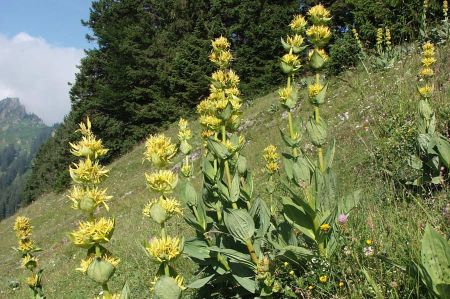Blooming yellow gentian on the slopes of Walmendinger Horn
- Written by Portal Editor
Our hike up to the Walmendinger Horn was not only an experience because of the truly indescribable view of the mountain panoramas in the area, but also the multitude of plants and herbs, some of which showed their full blooms, were simply fascinating in the variety of their variations.
As an example, we would like to briefly talk about gentian, which is certainly known to many readers as an important ingredient in medicines or alcoholic beverages.
First to recognize the effect of gentian species
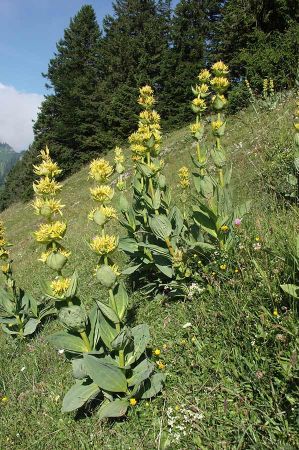 It should also be mentioned that the usefulness of these plants has been known for thousands of years. The botanical genus name Gentiana is still the original Greek name for species in this genus and is proven to have been used in this form since 50 to 100 AD. According to Dioscorides and Pliny the Elder, the name comes from the Illyrian king Genthios (180–168 BC), who is said to have been the first to recognize the healing properties of gentian species. Illyria was an area that was located near modern-day Albania and was therefore part of the Roman Empire at the time.
It should also be mentioned that the usefulness of these plants has been known for thousands of years. The botanical genus name Gentiana is still the original Greek name for species in this genus and is proven to have been used in this form since 50 to 100 AD. According to Dioscorides and Pliny the Elder, the name comes from the Illyrian king Genthios (180–168 BC), who is said to have been the first to recognize the healing properties of gentian species. Illyria was an area that was located near modern-day Albania and was therefore part of the Roman Empire at the time.
Today, Genthios is still used as a female name and Gentian as a name for both genders in Albania and surrounding areas.
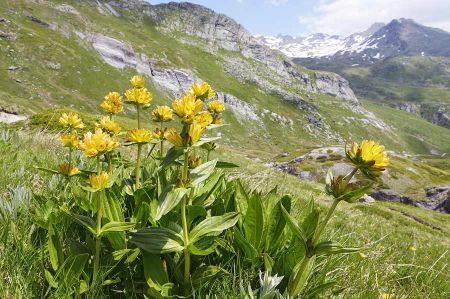 The “rootstocks” of some gentian species have been used in Central Europe since the Middle Ages to make schnapps, as medicine and to stimulate the appetite.
The “rootstocks” of some gentian species have been used in Central Europe since the Middle Ages to make schnapps, as medicine and to stimulate the appetite.
In contrast to the blue-flowering gentians depicted on many bottle labels, the large-growing species are used for distillation, especially and predominantly the yellow gentian (Gentiana lutea), the purple gentian (Gentiana purpurea), the spotted gentian (Gentiana punctata) and the Hungarian gentian (Gentiana pannonica) is used.
Gentiana species, on the other hand, are completely missing in Africa
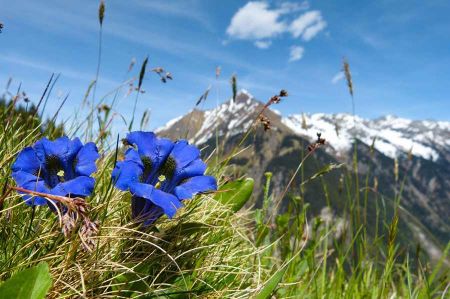 Gentians are also used as a bitter substance (amarum). The most bitter “natural” substance in the world, amarogentin, is obtained from the roots of certain species. Amarogentin is still clearly perceptible even at a dilution of one in 58 million, which means that even the smallest amounts are sufficient if you want to achieve a bitter aftertaste due to the taste. In many gentian species, the above-ground parts also taste bitter and are therefore clearly avoided by grazing cattle. This is one reason why gentian species have been able to survive particularly well in the grazed alpine meadows.
Gentians are also used as a bitter substance (amarum). The most bitter “natural” substance in the world, amarogentin, is obtained from the roots of certain species. Amarogentin is still clearly perceptible even at a dilution of one in 58 million, which means that even the smallest amounts are sufficient if you want to achieve a bitter aftertaste due to the taste. In many gentian species, the above-ground parts also taste bitter and are therefore clearly avoided by grazing cattle. This is one reason why gentian species have been able to survive particularly well in the grazed alpine meadows.
All European gentian species are protected, which means they may neither be picked nor dug up. Therefore, attempts are currently being made to cultivate the gentian required for the production of schnapps and a large part of the plants required for the production of schnapps and medicines are already being grown and harvested in fields as a special crop.
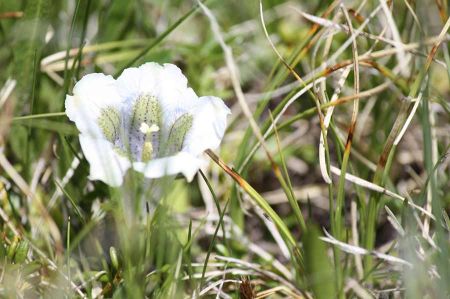 The Gentiana genus includes between 300 and 400 species worldwide, mainly in the temperate mountains of the Northern Hemisphere, but also in the Andes. Gentiana species, on the other hand, are completely missing in Africa. Around 35 species of Gentiana thrive in Europe, mainly in the Alps.
The Gentiana genus includes between 300 and 400 species worldwide, mainly in the temperate mountains of the Northern Hemisphere, but also in the Andes. Gentiana species, on the other hand, are completely missing in Africa. Around 35 species of Gentiana thrive in Europe, mainly in the Alps.
Gentian species grow as annual or biennial herbaceous plants. What was particularly interesting for us was the observation we later noticed while descending the valley, when noticeably cool rain clouds slid down into the valley. As if in fast motion, many flowers closed upon first contact with the cool, moist mists. A phenomenon that can sometimes also be observed when strong winds suddenly occur - weather-sensitive plants.
In general, there was an amazing display of flowers on the Walmendinger Horn!
Please read as well:
Sinkholes - Red and Blue Lake next to Imotski
Paulinenpark and church bell garden in Apolda
-
 Colourful flowers at Walmendinger Horn
Colourful flowers at Walmendinger Horn
Colourful flowers at Walmendinger Horn
Colourful flowers at Walmendinger Horn
-
 Colourful flowers at Walmendinger Horn
Colourful flowers at Walmendinger Horn
Colourful flowers at Walmendinger Horn
Colourful flowers at Walmendinger Horn
-
 Colourful flowers at Walmendinger Horn
Colourful flowers at Walmendinger Horn
Colourful flowers at Walmendinger Horn
Colourful flowers at Walmendinger Horn
-
 Colourful flowers at Walmendinger Horn
Colourful flowers at Walmendinger Horn
Colourful flowers at Walmendinger Horn
Colourful flowers at Walmendinger Horn
-
 Colourful flowers at Walmendinger Horn
Colourful flowers at Walmendinger Horn
Colourful flowers at Walmendinger Horn
Colourful flowers at Walmendinger Horn
-
 Colourful flowers at Walmendinger Horn
Colourful flowers at Walmendinger Horn
Colourful flowers at Walmendinger Horn
Colourful flowers at Walmendinger Horn
-
 Colourful flowers at Walmendinger Horn
Colourful flowers at Walmendinger Horn
Colourful flowers at Walmendinger Horn
Colourful flowers at Walmendinger Horn
-
 Colourful flowers at Walmendinger Horn
Colourful flowers at Walmendinger Horn
Colourful flowers at Walmendinger Horn
Colourful flowers at Walmendinger Horn
-
 Colourful flowers at Walmendinger Horn
Colourful flowers at Walmendinger Horn
Colourful flowers at Walmendinger Horn
Colourful flowers at Walmendinger Horn
-
 Colourful flowers at Walmendinger Horn
Colourful flowers at Walmendinger Horn
Colourful flowers at Walmendinger Horn
Colourful flowers at Walmendinger Horn
-
 Colourful flowers at Walmendinger Horn
Colourful flowers at Walmendinger Horn
Colourful flowers at Walmendinger Horn
Colourful flowers at Walmendinger Horn
-
 Colourful flowers at Walmendinger Horn
Colourful flowers at Walmendinger Horn
Colourful flowers at Walmendinger Horn
Colourful flowers at Walmendinger Horn
-
 Colourful flowers at Walmendinger Horn
Colourful flowers at Walmendinger Horn
Colourful flowers at Walmendinger Horn
Colourful flowers at Walmendinger Horn
-
 Colourful flowers at Walmendinger Horn
Colourful flowers at Walmendinger Horn
Colourful flowers at Walmendinger Horn
Colourful flowers at Walmendinger Horn
-
 Colourful flowers at Walmendinger Horn
Colourful flowers at Walmendinger Horn
Colourful flowers at Walmendinger Horn
Colourful flowers at Walmendinger Horn
-
 Colourful flowers at Walmendinger Horn
Colourful flowers at Walmendinger Horn
Colourful flowers at Walmendinger Horn
Colourful flowers at Walmendinger Horn
-
 Colourful flowers at Walmendinger Horn
Colourful flowers at Walmendinger Horn
Colourful flowers at Walmendinger Horn
Colourful flowers at Walmendinger Horn
-
 Colourful flowers at Walmendinger Horn
Colourful flowers at Walmendinger Horn
Colourful flowers at Walmendinger Horn
Colourful flowers at Walmendinger Horn
-
 Colourful flowers at Walmendinger Horn
Colourful flowers at Walmendinger Horn
Colourful flowers at Walmendinger Horn
Colourful flowers at Walmendinger Horn
-
 Colourful flowers at Walmendinger Horn
Colourful flowers at Walmendinger Horn
Colourful flowers at Walmendinger Horn
Colourful flowers at Walmendinger Horn
-
 Colourful flowers at Walmendinger Horn
Colourful flowers at Walmendinger Horn
Colourful flowers at Walmendinger Horn
Colourful flowers at Walmendinger Horn
https://www.alaturka.info/en/life/flora/6290-blooming-yellow-gentian-on-the-slopes-of-walmendinger-horn#sigProIda098cbb1a4
